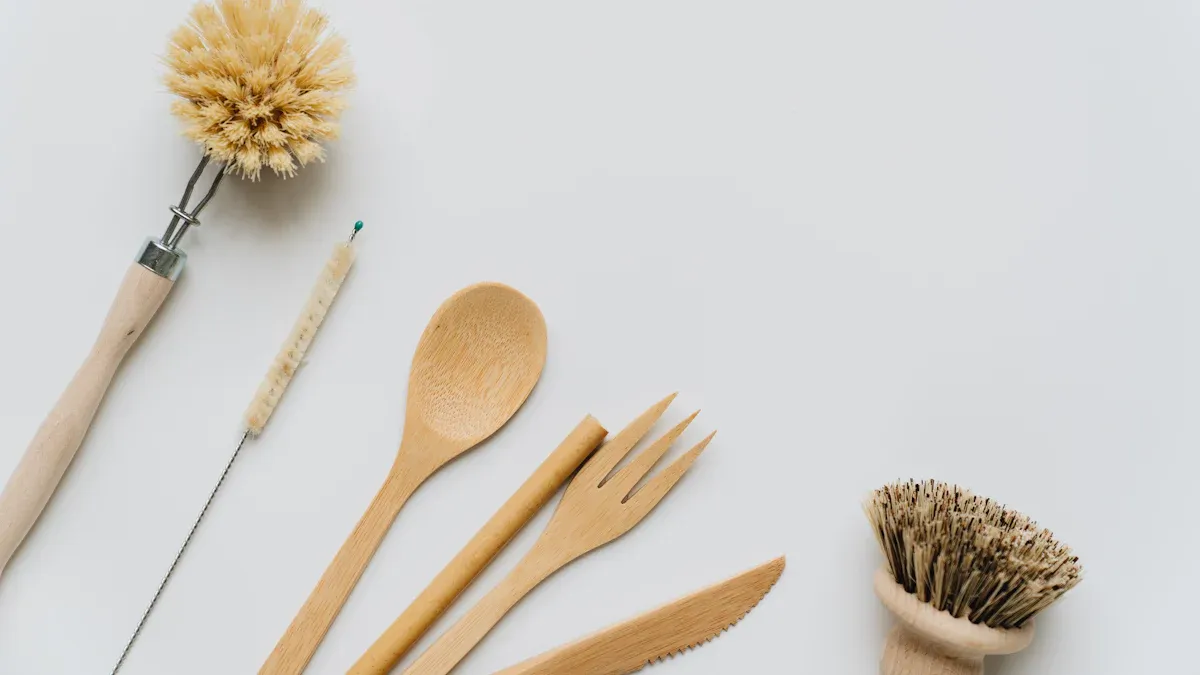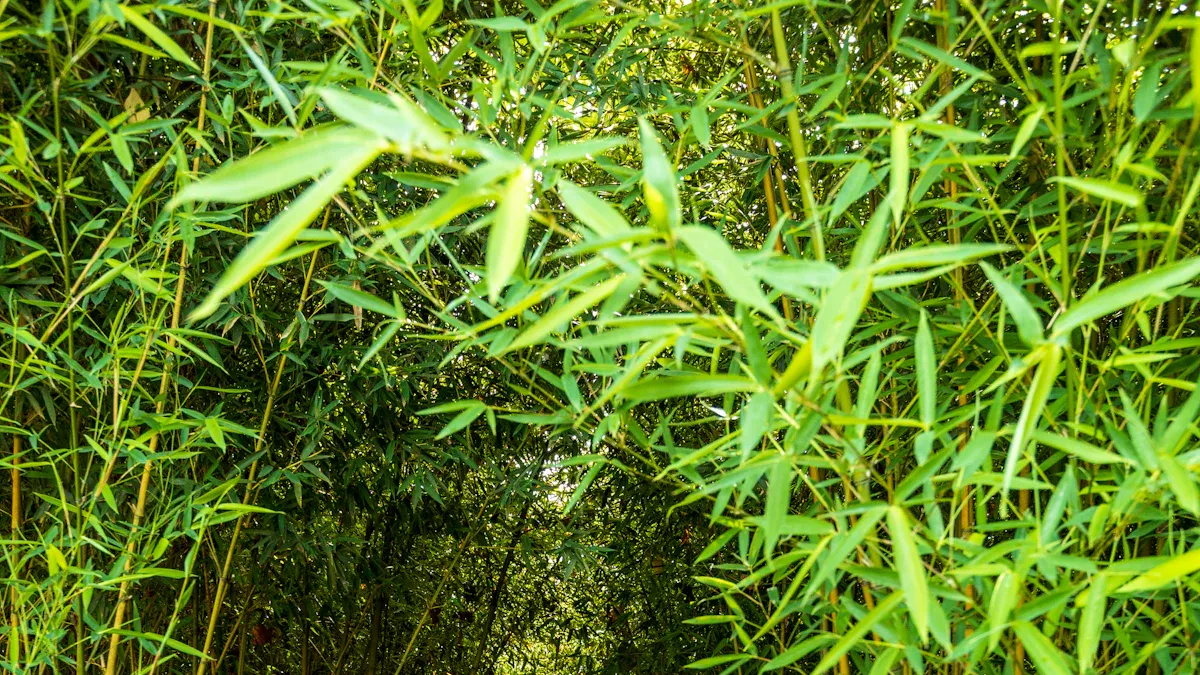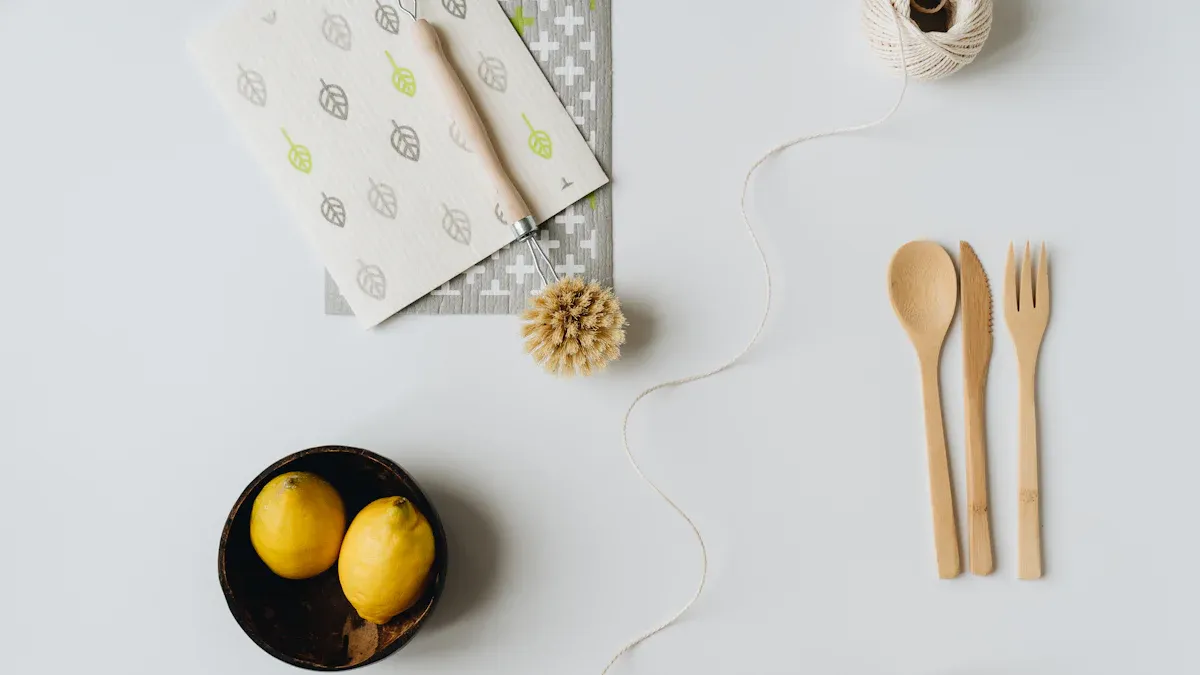
If you’re looking to create a sustainable and eco-friendly home, bamboo dinner trays are the perfect solution. By choosing bamboo dinner trays, you’re supporting earth-friendly products that help protect the planet. Bamboo dinner trays stand out as an eco-conscious choice because they’re made from fast-growing, renewable plants. Many people now prefer bamboo dinner trays over plastic or metal alternatives, making them a top pick among eco-friendly kitchen products.
Did you know? Bamboo tableware, including bamboo dinner trays, holds 18–20% of the global eco-friendly tableware market, highlighting the strong demand for bamboo kitchen utensils and trays.
| Market Segment | Bamboo Tableware Market Share (%) |
|---|---|
| Eco-friendly Tableware Market | 18–20 |
| Broader Kitchenware and Cookware | 4–5 |
| Sustainable Packaging & Dining | 6–7 |
| Home and Dining Accessories | 3–4 |
| Foodservice Disposables | 5–6 |
Bamboo kitchen utensils, bamboo dinner trays, and other bamboo trays help you build a greener kitchen. Choose bamboo dinner trays for tableware that’s durable, stylish, and supports a healthier planet.
Bamboo Dinner Trays as a Renewable and Sustainable Resource

Fast-Growing Bamboo Plants
You make a smart choice for the planet when you use bamboo dinner trays. Bamboo grows much faster than hardwood trees. While hardwoods can take up to 50 years to mature, bamboo reaches harvest size in just 3 to 5 years. Some bamboo species can grow up to 35 inches in a single day! This rapid growth means you get a steady supply of bamboo kitchenware without waiting decades for trees to regrow.
Bamboo is a grass, not a tree. After harvesting, bamboo regrows from its roots, so you do not need to replant it. This natural regrowth helps prevent soil erosion and keeps bamboo forests healthy. You support sustainable dining every time you choose bamboo trays or bamboo kitchen utensils. Bamboo plantations absorb up to 12 tons of CO2 per hectare each year and produce 35% more oxygen than the same area of trees. Scientific studies show that bamboo stores about 70% more carbon per acre annually than hardwoods. This makes bamboo products a top pick for eco-friendly homes.
Tip: Bamboo kitchenware is naturally pest-resistant, so farmers do not need to use chemical pesticides. You get safer, cleaner bamboo trays and bamboo serving boats for your family.
Minimal Land and Water Use
Bamboo needs less land and water than traditional timber sources. You help save valuable resources by choosing bamboo kitchen utensils and bamboo trays. Bamboo yields up to 20 times more timber per hectare than trees. This means you get more sustainable kitchenware from a smaller area. Bamboo’s deep roots help it thrive with less water, making it a sustainable resource even in dry climates.
Bamboo serving boats and bamboo trays use less energy and resources during production. The lightweight nature of bamboo products also reduces transportation emissions. When you pick bamboo kitchenware, you support sustainable dining and lower your carbon footprint.
| Certification/Standard | Purpose/Description |
|---|---|
| FSC-CoC | Ensures sustainable sourcing of bamboo from responsibly managed forests |
| FDA 21 CFR 175.300 | Compliance for food-contact safety |
| BPA-free seals | Assurance of no harmful chemicals in product |
Bamboo dinner trays often meet strict environmental standards, such as FSC certification. This guarantees that your bamboo kitchenware comes from responsibly managed bamboo forests. You make a positive impact on the environment every time you choose bamboo products for your home.
Biodegradability and Waste Reduction with Bamboo Tableware
Natural Breakdown After Use
You want your kitchen to support a cleaner planet. Choosing biodegradable tableware like bamboo dinner trays makes a real difference. Unlike plastic, which can stay in landfills for hundreds of years, bamboo tableware breaks down naturally in just a few months. A recent study from UBC shows that bamboo containers decompose within six months in home composting conditions. This means you can toss your disposable bamboo plates into your compost bin, and they will return to the earth quickly.
- Bamboo and straw fiber materials decompose in 2 to 6 months with enough heat, moisture, and oxygen.
- Composting bamboo trays at home or in industrial facilities enriches the soil and reduces methane emissions.
- Avoid bamboo products with plastic or wax coatings, as these slow down the breakdown process.
Tip: Composting your bamboo tableware at home helps reduce landfill waste and supports healthy soil in your garden.
Reducing Plastic and Single-Use Waste
You help fight plastic pollution every time you choose biodegradable tableware. Bamboo tableware is home compostable and contains no synthetic polymers. It avoids the long-term pollution problems caused by plastic. Plastic tableware can take centuries to break down, but bamboo products disappear in months. This quick breakdown means less waste in landfills and fewer toxic residues in the environment.
| Material Type | Biodegradability & Compostability | Carbon Footprint Reduction vs Plastic |
|---|---|---|
| Bamboo/Wood | Home compostable; biodegrades in months to a couple of years | 70-80% lower CO₂ emissions |
| Plastic | Not biodegradable; can take centuries to degrade | Baseline (100%) carbon footprint |
| PLA Bioplastic | Industrially compostable; similar to plastic | Similar to plastic |
Switching to disposable bamboo plates and other biodegradable tableware helps you lower your carbon footprint. You also prevent microplastics from entering the soil and water. By making this simple change, you support a cleaner, greener planet for everyone.
Chemical-Free and Safe Bamboo Kitchenware

No Harmful Additives or Toxins
You want to keep your meals safe and your family healthy. Pure bamboo kitchenware gives you peace of mind because it does not contain harmful chemicals found in many other kitchen products. Disposable plastic containers often leach dangerous substances into your food, especially when heated. These chemicals can enter your body and cause health problems over time. With bamboo kitchenware, you avoid this risk. Pure bamboo kitchen utensils do not use glues, lacquers, or synthetic coatings, so you never have to worry about toxins mixing with your meals.
Many non-bamboo kitchenware products contain chemicals that you do not want near your food. Here are some common examples you avoid with pure bamboo:
- PFAS: Used in non-stick coatings, these “forever chemicals” can build up in your body.
- Lead compounds: Sometimes found in ceramic glazes, lead can leach into food and cause serious health issues.
- Melamine: Used in some bamboo composites, melamine can be harmful if it enters your food.
- Plastic chemicals: Polyethylene and polypropylene can release unknown substances when heated.
You make a smart choice for your kitchen by choosing bamboo kitchen utensils made from 100% bamboo. You keep your food pure and your family safe.
Healthier for You and the Environment
You care about your health and the planet. Bamboo kitchenware supports both. When you use chemical-free bamboo trays and utensils, you protect your body from harmful additives. You also help the environment by preventing chemical pollution. Unlike plastic or chemically treated products, bamboo kitchenware does not release toxins into the soil or water when composted. This keeps compost rich and healthy for plants.
Regulations help keep bamboo kitchenware safe. Manufacturers must test for formaldehyde, lead, and pesticide residues. They also check for mold and bacteria. Third-party labs verify that products meet strict safety standards before they reach your home.
| Regulation / Standard | Key Chemical Safety Requirements |
|---|---|
| FDA 21 CFR Parts 170-199 | Restricts harmful substances and requires migration testing |
| California Proposition 65 | Limits hazardous substances like formaldehyde and lead |
| ASTM Standards | Sets test methods for chemical safety and product compliance |
You enjoy the safety and health benefits of bamboo kitchenware every day. You make a positive impact on your well-being and the environment with every meal.
Energy-Efficient Production and Low Carbon Footprint of Bamboo Dinner Trays
Lower Energy Use in Manufacturing
You make a smart choice for the planet when you pick bamboo trays for your kitchen. The manufacturing process for bamboo trays uses less energy than many other materials. Bamboo grows quickly and does not need replanting after harvest. This means you get a steady supply of material without using extra resources. Producers avoid chemical treatments, dyes, and bleaches during production. This reduces toxic emissions and saves energy.
Bamboo dinner trays stand out because they use renewable materials. You help protect natural resources every time you choose bamboo trays. Unlike plastic or ceramic, bamboo trays require less energy to produce. Plastic plates come from fossil fuels and need a lot of energy to make. Ceramic trays need high-temperature kilns, which use even more energy. Bamboo trays skip these steps, making them a more sustainable option for your home.
Tip: When you use bamboo trays, you support a cleaner production process and help lower energy use in your kitchen.
Reduced Greenhouse Gas Emissions
You can lower your carbon footprint by switching to bamboo trays. Bamboo production creates much less greenhouse gas than steel, plastic, or paper. For example, choosing a bamboo product instead of a steel one can save about 25 kg of greenhouse gases. That is like avoiding a 101 km car trip! Bamboo grows fast—up to one meter per day—and matures in just four to five years. It keeps its roots in the ground after harvest, which helps store carbon and protect the soil.
Other materials, like plastic and styrofoam, cause big problems for the environment. They come from fossil fuels and release greenhouse gases during production. Paper plates need trees, lots of water, and chemicals, which also increase emissions. In contrast, bamboo trays are compostable and do not need chemical coatings or pesticides. This makes them a cleaner, greener choice.
Here is how bamboo compares to other materials:
| Material | Environmental Characteristics | Carbon Footprint Considerations |
|---|---|---|
| Bamboo | Fast-growing, renewable, minimal water and no pesticides used | Lower energy needs in production; naturally biodegradable |
| Ceramic | Made from natural clay; concerns with lead glazes | Energy-intensive firing process; some reduction if recycled |
| Glass (Recycled) | Made from post-consumer glass; reduces raw material use | Lower energy and raw material needs due to recycling |
You help fight climate change every time you use bamboo trays. You support a sustainable future for your family and the planet.
Durability and Reusability of Bamboo Tableware
Long-Lasting and Sturdy
You want tableware that stands up to daily use. Bamboo dinner trays deliver impressive strength and reliability. When you choose bamboo kitchenware, you get products that last for years. Well-maintained bamboo kitchen utensils can serve you for over two years, even with regular use. High-quality bamboo dinner trays often last up to five years or more in your home. Some bamboo kitchen items, like utensils, have been known to last a decade with proper care.
Bamboo’s natural strength comes from its fiber structure. The USDA Forest Products Laboratory confirms bamboo’s high tensile strength and stiffness. This means your trays resist cracking and breaking better than plastic alternatives. You can carry heavy meals, laptops, or coffee machines without worry. Customers praise bamboo trays for their sturdy build and lightweight feel. Features like easy-grip handles and smooth, splinter-free surfaces make them safe for kids and adults.
| Property/Aspect | Bamboo Fiber Dishware (BFD) | Comparison/Notes |
|---|---|---|
| Tensile Strength | 1710 MPa | High strength for daily use |
| Elastic Modulus | 27.1 GPa | Toughness and stiffness |
| Creep Resistance | Greater than PLA dishware | Maintains shape over time |
Tip: Hand wash your bamboo kitchenware, dry it immediately, and apply finishing oil occasionally. These simple steps help your trays stay strong and beautiful for years.
Fewer Replacements, Less Waste
You save money and help the planet when you choose reusable bamboo kitchen utensils. Bamboo trays require less maintenance than wooden trays and outlast many biodegradable alternatives. You avoid frequent replacements, which means less waste in your kitchen. Unlike plastic trays that crack or stain, bamboo trays resist wear and keep their smooth surface with basic care.
Customers report high satisfaction with bamboo dinner trays. They use them for charcuterie boards, organizing, and even as portable desks. Reviews highlight that trays do not peel, stain, or degrade easily. You can trust bamboo kitchenware to stay reliable for years, reducing your need to buy new tableware often.
- Bamboo trays are less prone to cracking than plastic.
- You spend less time and money on upkeep compared to wooden trays.
- Trays remain versatile and safe for daily use.
A life cycle assessment shows bamboo fiber tableware benefits the environment across all disposal methods. You support a cleaner planet by choosing products that last longer and create less waste. Make the switch to bamboo dinner trays and enjoy durable, reusable tableware every day.
You can make a real difference for the planet by choosing bamboo dinner trays. These eco-friendly products offer five clear benefits:
- Bamboo grows fast and renews quickly, making it highly sustainable.
- Dinnerware made from certified organic bamboo reduces environmental impact.
- Bamboo trays are durable, lightweight, and compostable, cutting down on waste.
- Natural antibacterial properties keep your kitchen safe.
- Switching to bamboo kitchenware helps fight plastic pollution and supports a healthier planet.
The bamboo tableware market is set to double by 2033, driven by consumer demand for sustainable choices. Make the switch today and help build a greener future.
FAQ
Are bamboo dinner trays safe for food contact?
You can trust bamboo dinner trays for food safety. Most trays meet strict standards like FDA 21 CFR 175.300. Manufacturers test for harmful chemicals. You get a natural, toxin-free surface for your meals. Always check for certifications before buying.
How do I clean and care for bamboo dinner trays?
You should hand wash bamboo trays with mild soap and water. Dry them right away. Avoid soaking or using dishwashers. Apply food-safe oil every few months. This keeps your trays strong and looking new.
Tip: Quick drying prevents warping and extends the tray’s life.
Can I compost bamboo dinner trays at home?
Yes, you can compost pure bamboo trays. They break down in 2–6 months in home compost bins. Remove any coatings or non-bamboo parts first. Composting bamboo trays helps enrich your soil and reduces landfill waste.
How do bamboo trays help the environment?
Bamboo trays support a healthier planet. Bamboo grows fast, absorbs more CO₂ than trees, and needs less water. You reduce plastic waste and lower your carbon footprint by choosing bamboo. Scientific studies show bamboo stores 70% more carbon per acre than hardwoods.
What certifications should I look for when buying bamboo trays?
Look for certifications like FSC-CoC for sustainable sourcing and FDA approval for food safety. These labels guarantee you get eco-friendly and safe products. Certified bamboo trays meet strict environmental and health standards.

